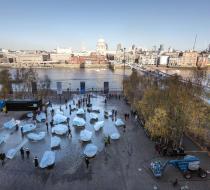Ice Watch Favorite
Does it vex you, the environmental impact of Olafur Eliasson’s Ice Watch? Do you hear about the transportation of 30 icebergs from the Nuup Kangerlua fjord in Greenland to be displayed in London as a memento mori for our inhabitable environment and judge the project a bit of an own-goal, sustainability-wise? You would not be alone – on personal evidence, this seems a popular response. Minik Rosing, Professor of Geology at the Natural History Museum of Denmark, is a regular sounding board for Eliasson on matters environmental. He’s credited as co-author of Ice Watch and suggests that such gripes illustrate a failure to grasp the sheer scale of the issue. 'An iceberg like that? Greenland loses 10,000 every second so you can take 30 of them: it’s not going to change anything,’ he says. ‘Or hopefully it is going to change something: an awareness of what is happening, so maybe we’ll make changes in our behaviour.'
As with intensities and surfaces, what we’re invited to admire in Ice Watch is the mysterious action of natural forces. Each berg has a distinct form, variations in texture and opacity. Made from 10,000-year-old snowfall compacted over time by cumulative weight, the bergs are white with air trapped within from where it settled between snowflakes. The clear streaks of ice striping some bergs are evidence of temperature fluctuation: ice melting, the water pouring into a crack and then freezing again. This is not the first edition of Ice Watch – in previous years, bergs have melted in the streets of Paris and Copenhagen – nor is it the first time that Eliasson and Rosing have presented a worked together. In 2016 their Glacial rock flour garden was shown as part of Eliasson’s exhibition at Versailles. Clay-like rock dust filled the basin of a pond surrounding a statue of Pluto abducting Persephone. As a symbol, the goddess of fertility was apt: it is the rich mineral content of the ‘rock flour’ that interests Rosing.
For Rosing, working with Eliasson brings a different perspective – the eye of an artist alongside the eye of a scientist – and above all, an appeal to the emotions. Years spent in education, he says, have shown him that you can’t teach people anything: all you can do is inspire them to want to learn. For Rosing, the key to Ice Watch is its spectacle: the beauty of the bergs. He wants people to admire them, to listen to the popping of the air bubbles, to stroke their smooth surfaces and wonder what strange forces formed them. And to watch how fast they melt, and realise how fragile they are. ‘Art can inspire someone to want to do something,’ he says. ‘But science can tell them what to do and how to do it.’








